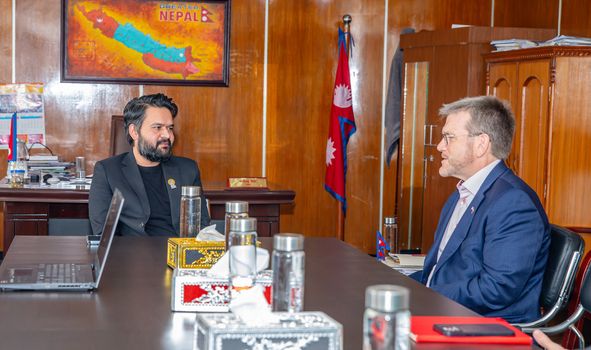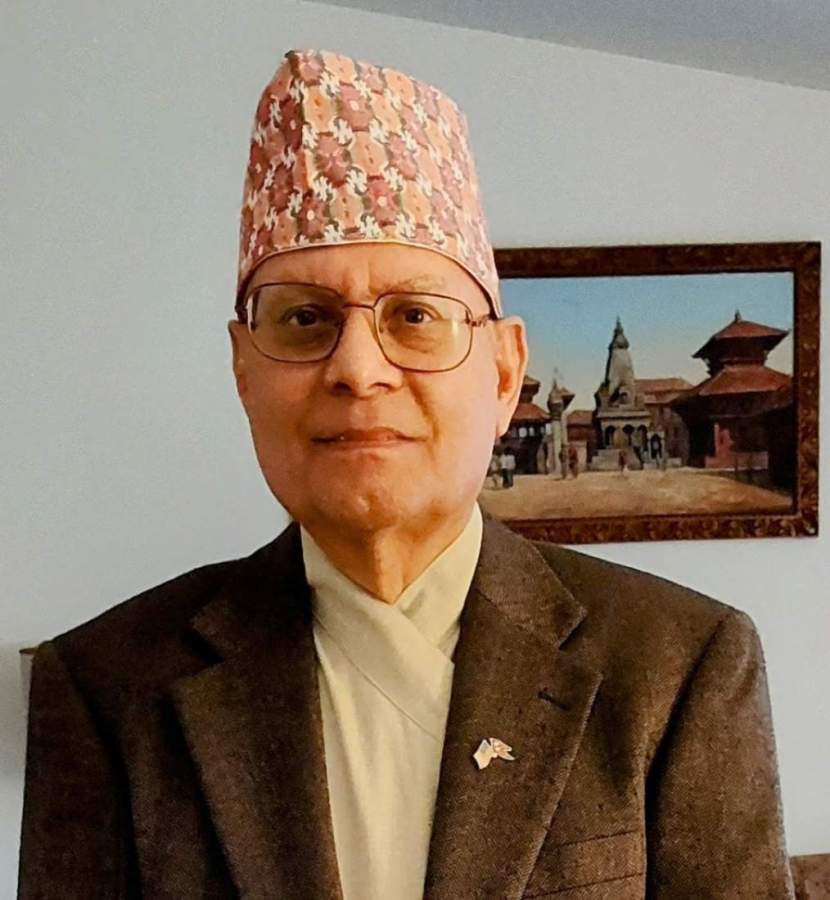

Not too long ago, the American Ambassador to Nepal Mr. Dean R. Thompson had an audience with the Mayor. What is interesting is the depiction of a historic map of the “Greater Nepal.” In the front of the rather controversial map, the Ambassador and the Mayor were seen as the supporting witnesses of the
campaign. Just a few months ago, the Mayor of the Metropolitan City of Kathmandu, Mr. Balendra Shah, who is very popularly recognized as Mayor Balen hang the map in the forefront of his Mayoral office. The incident made the headline news in Nepal and the neighboring countries, including India. Mayor Balen’s act was in fact in exchange of Indian Prime minister Mr. Damodar Das Modi’s endorsed exhibition of a huge mural on the wall of the recently inaugurated parliament building in New Delhi. Obviously, the act of Mayor Balen was in protest of Mr. Modi’s hegemonic showoff in South Asia neighborhood. Last year, when the Indian Prime Minister Modi inaugurated the New Parliament building, he tried to draw his audience’s attention to focus their mind on the Mural of “Akhanda Bharat”. The Mural includes many integral parts of Nepal. For example, some pre-historic as well historic landmarks of Nepal, such as
Janakpurdham, the birthplace of Sita Mata, Lumbini, the birthplace of Lord Buddha, Kapilvastu, Biratnagar etc and many other parts of present day Nepal have been shown within “Akhada Bharat.” The Mural did not only invade Nepali territories, but also parts of Bangladesh, Pakistan and Myanmar have been included within Akhanda Bharat, India. Naturally, the neighbors have protested against and condemned the display of the Mural in the most important building of India. Mayor Balen certainly proved his courage and love for Nepal by hanging the map of the Greater Nepal in the forefront of his office, in retaliation of PM Modi’s intent. The photo op of the American Ambassador and the Mayor in front of the map of the Greater Nepal can be taken as an indication of support by the U.S. Government towards the campaign which has gained momentum in Nepal, lately. The question is, if the Indian Premier can promote something pre-historic legend, what is wrong if Mayor Balen hangs the map of “Greater Nepal” which was in fact, the reality of the modern era? Because, The Greater Nepal was the truth until 1816 when the British East India Company occupied and merged Nepali territories into their colony of India. The occupation of Greater Nepal’s land was merely based on a very deceitfully drafted document called the Treaty of Sugauli. The Treaty had never been ratified by the King or the Prime Minister of Nepal. Unfortunately, the so-called Treaty was imposed on Nepal unilaterally by the British Colonialist. They declared war on Nepal, which is known as Anglo-Nepal war of 1814-1816. However, they still could not defeat Nepal for a protracted period of almost two years.
The highly publicized Mural in the newly constructed Indian parliament building in New Delhi and the subsequent high light on the map of the Greater Nepal in Kathmandu generated some news that became viral in both Capitals. Again, the truth is that the Indian mural is pre-historic legend whereas the Greater Nepal is a reality. Therefore, dwelling on the real facts rather than on fictitious story will be more warranted in the following paragraphs.
The Greater Nepal was the unified Nepal which was started by King Prithvi Narayan Shah and that was continued by his son Prince Bahadur Shah in order to save Gorkha and dozens of small Kingdoms of the region from the invading British East India Company. The fact of the matter is that there would be no country called Nepal in existence today, if Prithvi Narayan had not defeated the first British invasion. Nepal and several dozens of small Kingdoms of the region would have been swallowed up by the British and merged them into their colony, overtwo hundred fifty years ago.
Another truth is that there is no part of today’s India within the lost territories of Greater Nepal. Truthfully, there was no country named India before the British colonized more than five hundred kingdoms of South Asian Subcontinent. India came in today’s shape and size only after British Government de colonized the ubcontinent and created two countries of Pakistan and India in 1947.
Pakistan was divided into two parts, East Pakistan and West Pakistan and India in the middle. East Pakistan got independence from Pakistan and turned into Bangladesh, in 1972. India played a major role increating Bangladesh. It is widely believed that the British had intended to return the lands of Greater Nepal which they had looted after the Anglo-Nepal War. They were fully aware of the fact that the so-called Treaty of Sugauli was unfair and done deceitfully. They wanted to return the occupied land back to its legitimate owner when they decided to grant independence to Pakistan and India. The British had contemplated the value of the military assistance given to them by Prime Minister Jung Bahadur Rana in quelling the Sepoy Mutiny of 1857 that had proved a great help to save their Empire. Furthermore, the British had also realized the importance of the sacrifice made by tens of thousands of Nepali soldiers during World War I and World War II in order to save their Empire.
Before the independence of India, the freedom fighters such as Mahatma Gandhi,awaharlal Nehru, Ballav Bhai Patel among others knew that the British had planned to return the occupied land to Nepal. The first PM, Nehru has even written in one of his books that the British had occupied Nepal’s land that needs to be return to Nepal. However, during the negotiation for independence, the Indian leaders hatched a conspiracy to keep the occupied land of Greater Nepal within India. During the partition, the Hindus and Muslims interest clashed for bigger portions of the land. Unfortunately, Nepal had no representation at the crucial time.
After the Indian independence, the politics in Nepal also saw some dramatic changes. The home minister of the newly installed Government, Mr. Patel proposed to merge Nepal into India. Nehru disagreed with Patel to use force to take Nepal. He did not want to tarnish the image of newly independent India by
invading an independent neighbor. Nehru and his close advisors apparently adopted a slow and steady approach towards Nepal.
In the meantime, the political situation in Nepal could not remain as usual. King Tribhuvan wanted to take the power back from the hereditary Rana regime. The Ranas would obviously want to stick to power as long as possible.
After the de-colonization, the Ranas had lost the blessings of the British and they had to substitute the same from the Indian leaders in power. The last but not the least was the newly emerging leadership in Nepali politics. All three sets of actors had their own agendas, self-interest and some weaknesses.
King Tribhuvan, in order to oust the Rana had the support of Nepali people. However, peoples rally alone was not enough for the King to restore a powerful Monarchy. The King was encouraged and assisted by the Indian leadership to go into exile in India. Consequently, King Tribhuvan and rest of the Royal family
exiled in New Delhi and remained there as a guests for several weeks. Nehru and his subordinates had been pressuring the King indirectly and in a diplomatic manner for him to agree to bring Nepal under the Indian control. Under such circumstances, the King could possibly not the raise question for the restoration of the Greater Nepal.
The Ranas as mentioned earlier had become desperate to cling into power and continue their regime. They had to please the Indian Government and leaders by all means. Besides, the Ranas were afraid of losing all their wealth and the properties they had amassed in India. They could not dare to talk about lost land of the Greater Nepal.
Thirdly, most of Nepali political leaders and their followers were either self- exiled, born, educated and trained in India. Most of them were the followers of the Indian freedom fighters like Gandhi, Nehru, Patel, Jaya Prakash Narayan among others. Some of them even went to jail with their Indian mentors. Those
Nepalis could possibly not speak in favor of Greater Nepal either. Under the circumstances, during the crucial time of the partition of India, no powerful and effective voice could emerge claiming the return of the lost land of Nepal. Unfortunately, the golden chance for the restoration of Greater Nepal was lost. India has continued to occupy the Nepali land that had to be returned and freed from the Indian occupation just like the rest of India and Pakistan and Bangladesh were freed from British colonialism in 1947.
The reason why Nepal has remained poor, backward and unstable is mainly due to her geography. Nepal has remained India locked from three sides. In the northremains the formidable Himalayan range. Since its independence, India has been conspiring to merge Nepal into India. India has not only continued to occupy Greater Nepal’s territories but also has occupied present day Nepal’s land in Kalapani, Lipu lake, Limpia Dhura, Susta and has also encroached Nepali land across the border in more than six dozen places.
Indian leaders tried to pressure King Tribhuvan to negotiate the sovereignty of Nepal. It is believed that the king turned down the Indian leader’s proposed of to make him the King of India if he agreed to merge Nepal with India.
King Mahendra had to face the Indian leaders the same way. But King Mahendra was a benevolent Monarch, he knew the politics very well. He established Nepal in the international stage and opened the country to the world. It was King Mahendra’s effort that earned the United Nations membership to Nepal. King Mahendra was the savior of Nepal.
King Birendra had no less stressful life in dealing with the Indian hegemony. The Indian leadership directly and indirectly pressured the king to come under their umbrella. He did not want to compromise with the Indian leaders. He rather negotiated with his people and chose to remain as a constitutional monarch.
Last but not least, even King Gyanendra did not negotiate with the foreign force at the cost of Nepal’s interest. He refused to be under the Indian umbrella as well. He rather gave up his throne to avoid the bloodshed in the country.
The gist of this write-up is the restoration of The Greater Nepal has remained in a state of slumber for over two centuries. However, after the political change of 1990, some people like Phanindra Nepal, Surendra Dhakal and few others have dared to raise question about Greater Nepal. Unfortunately, very few politicians want to talk about the subject. The main reason of their silence is that they are afraid of India. However, Mayor Balendra Shah has proved himself brave enough supporting the campaign for the Restoration of “The Greater Nepal”.
By Uttam B. Khatri Silver Spring, MD, USA

Comment